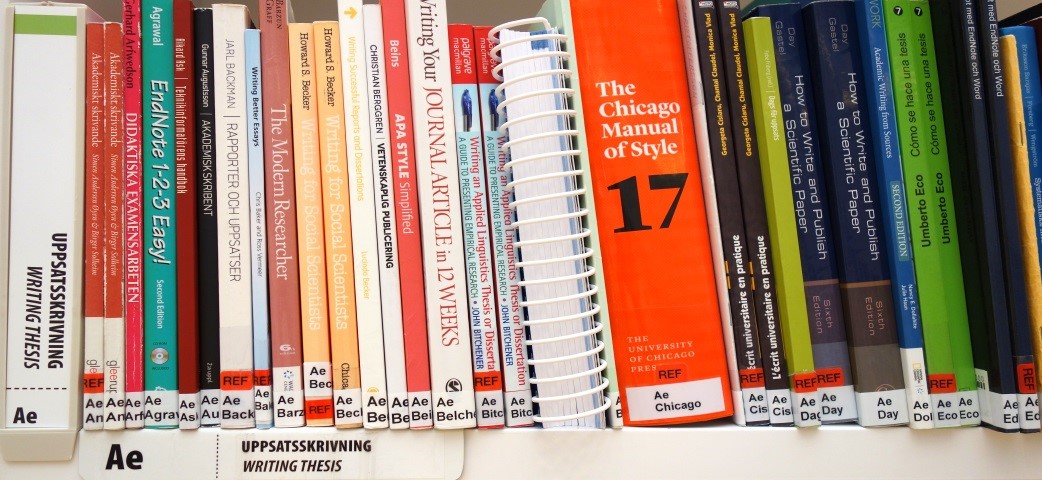
Referencing
When you are writing an academic text, it is important that you cite the sources that you use to clarify where you have taken the information from and to distinguish your ideas from those of others. If you use another person's work without citing the source, you risk committing plagiarism. How you should cite sources depends on what citation style you use. Always check with your teacher which style you should use. Here follows information on guides for some citation styles:
Guides for citation styles
APA
Publication Manual of the American Psychological Association (7th ed.) is the official manual for the APA style. You also find some information about the style on the APA Style website.
Chicago
The Chicago Manual of Style (17th ed.) is the official manual for the Chicago style. You also find some information in the Chicago-Style Citation Quick Guide online.
Harvard
Harvard Referencing (Technological University of the Shannon)
IEEE
IEEE Editorial Style Manual is the official manual for the IEEE style.
MLA
MLA Handbook (8th ed.) is the official manual for the MLA style. You also find some information in the MLA Formatting and Style Guide (Purdue University Online Writing Lab).
Oxford
Oxford Referencing (Victoria University Library)
Vancouver
Vancouver Referencing Style (University of Queensland Library)
Reference Management Programs
There are several programs available to help you manage references. These programs enable you to retrieve references from different databases and collate them in pdf format. You can also create citations and literature lists in your documents, allowing you to keep better track of your references. We recommend two programs for reference management: Zotero for students and EndNote for researchers and students who aim to become researchers.
Zotero
Zotero is a reference management program that you can download for free and continue to use even after you have completed your studies at the university. The library’s guide to Zotero contains more information and helps you get started.
EndNote
You can install EndNote on your computer with help of a licence. The page on software licenses provides staff information on how to install EndNote. Students can download EndNote from the page Software Licences for Students.
Clarivate's training resources help you to get started with EndNote.
Contact the library at bibinfo@du.se if you need help with EndNote or Zotero.
Copyright
When you create a work, for example, your dissertation, it is automatically protected by the Copyright Act (1960:72). You are therefore entitled to determine how your work may be used. Others are not entitled to claim the content of your work as their own, disseminate it or copy it freely. When you use other people's work, it is important that you also abide by copyright laws.
Rules for Copying
The right to copy is limited according to the Copyright Act. Students and teachers have the right to copy and disseminate copyrighted material for educational purposes since the university has license agreement with Bonus Copyright Access. The license does not entitle you to copy and disseminate audio or moving image files.
How much digital material are you permitted to copy and disseminate?
You may download, photograph or print out a maximum of 15 A4 pages of digital material per item, student/teacher and calendar year.
How much printed material are you permitted to copy and disseminate?
For printed material, the 15/15 rule applies. This means that you can copy and scan up to 15 percent, but no more than 15 pages per item, student/teacher and calendar year.You may however copy up to three extra pages if necessary in order to complete a section.
How much are teachers permitted to copy?
Teachers are permitted to copy material for their students according to the 15/15 rule so that students receive their copies and the teacher may retain some copies. You may also make a paper copy of a book without considering the 15/15 rule, however you are not permitted to copy and save the book in digital form.
Plagiarism
Plagiarism is the act to taking someone else's work and passing it off as your own. It is called self-plagiarism if you reuse your own copyrighted material without clearly referring to the text used. Plagiarism is considered a violation of proper academic practice and may lead to the suspension of your studies. To avoid plagiarism, it is important that you reference and cite correctly when using other people's texts.
Refero is a web-based teaching tool that helps you understand what plagiarism is and how to avoid it. The Plagiarism Handbook from Ouriginal (Urkund) can also be useful.
At Dalarna University, teachers use SafeAssign to check for cases of plagiarism in students' work (manual SafeAssign (pdf)).